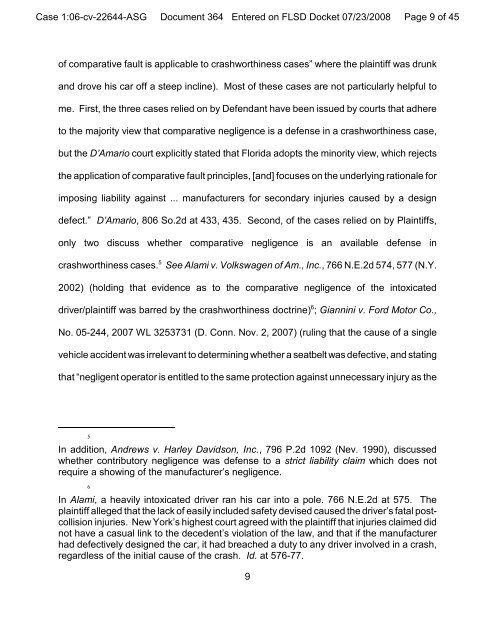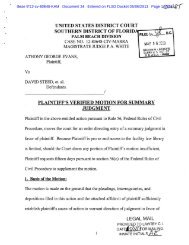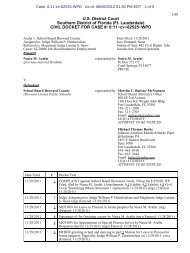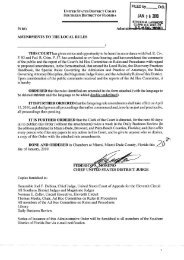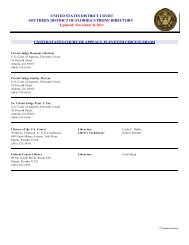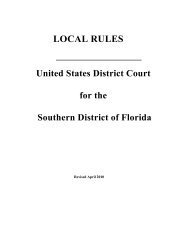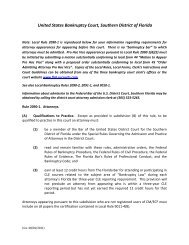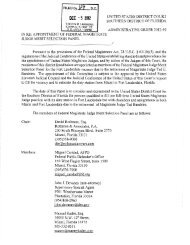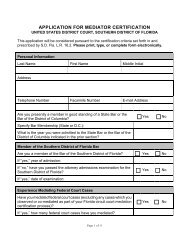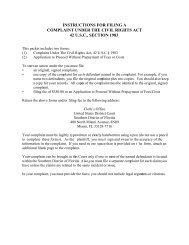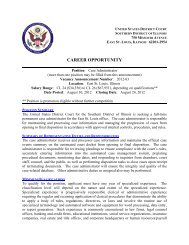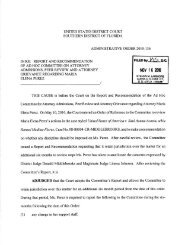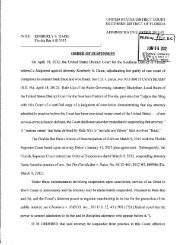Motion in Limine - United States District Court
Motion in Limine - United States District Court
Motion in Limine - United States District Court
You also want an ePaper? Increase the reach of your titles
YUMPU automatically turns print PDFs into web optimized ePapers that Google loves.
Case 1:06-cv-22644-ASG Document 364 Entered on FLSD Docket 07/23/2008 Page 9 of 45<br />
of comparative fault is applicable to crashworth<strong>in</strong>ess cases” where the pla<strong>in</strong>tiff was drunk<br />
and drove his car off a steep <strong>in</strong>cl<strong>in</strong>e). Most of these cases are not particularly helpful to<br />
me. First, the three cases relied on by Defendant have been issued by courts that adhere<br />
to the majority view that comparative negligence is a defense <strong>in</strong> a crashworth<strong>in</strong>ess case,<br />
but the D’Amario court explicitly stated that Florida adopts the m<strong>in</strong>ority view, which rejects<br />
the application of comparative fault pr<strong>in</strong>ciples, [and] focuses on the underly<strong>in</strong>g rationale for<br />
impos<strong>in</strong>g liability aga<strong>in</strong>st ... manufacturers for secondary <strong>in</strong>juries caused by a design<br />
defect.” D’Amario, 806 So.2d at 433, 435. Second, of the cases relied on by Pla<strong>in</strong>tiffs,<br />
only two discuss whether comparative negligence is an available defense <strong>in</strong><br />
5<br />
crashworth<strong>in</strong>ess cases. See Alami v. Volkswagen of Am., Inc., 766 N.E.2d 574, 577 (N.Y.<br />
2002) (hold<strong>in</strong>g that evidence as to the comparative negligence of the <strong>in</strong>toxicated<br />
6<br />
driver/pla<strong>in</strong>tiff was barred by the crashworth<strong>in</strong>ess doctr<strong>in</strong>e) ; Giann<strong>in</strong>i v. Ford Motor Co.,<br />
No. 05-244, 2007 WL 3253731 (D. Conn. Nov. 2, 2007) (rul<strong>in</strong>g that the cause of a s<strong>in</strong>gle<br />
vehicle accident was irrelevant to determ<strong>in</strong><strong>in</strong>g whether a seatbelt was defective, and stat<strong>in</strong>g<br />
that “negligent operator is entitled to the same protection aga<strong>in</strong>st unnecessary <strong>in</strong>jury as the<br />
5<br />
In addition, Andrews v. Harley Davidson, Inc., 796 P.2d 1092 (Nev. 1990), discussed<br />
whether contributory negligence was defense to a strict liability claim which does not<br />
require a show<strong>in</strong>g of the manufacturer’s negligence.<br />
6<br />
In Alami, a heavily <strong>in</strong>toxicated driver ran his car <strong>in</strong>to a pole. 766 N.E.2d at 575. The<br />
pla<strong>in</strong>tiff alleged that the lack of easily <strong>in</strong>cluded safety devised caused the driver’s fatal postcollision<br />
<strong>in</strong>juries. New York’s highest court agreed with the pla<strong>in</strong>tiff that <strong>in</strong>juries claimed did<br />
not have a casual l<strong>in</strong>k to the decedent’s violation of the law, and that if the manufacturer<br />
had defectively designed the car, it had breached a duty to any driver <strong>in</strong>volved <strong>in</strong> a crash,<br />
regardless of the <strong>in</strong>itial cause of the crash. Id. at 576-77.<br />
9


